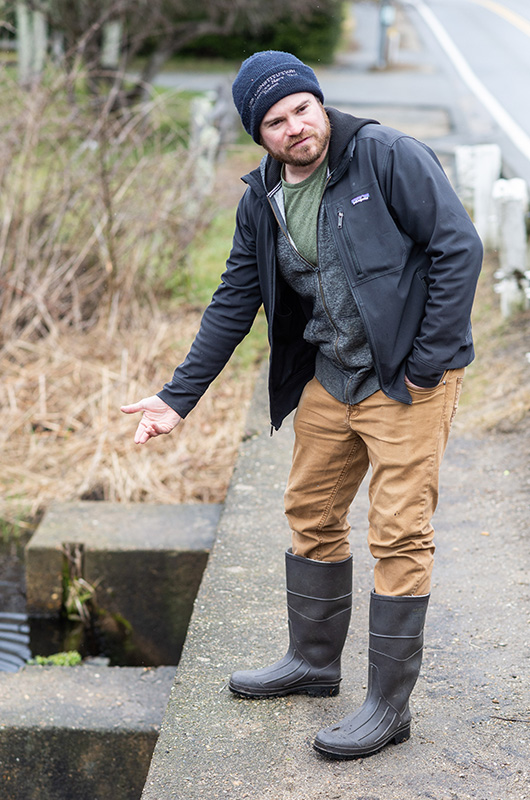As voters flip through their annual town reports on the meeting floor this year, most of the officials and departments are likely to be familiar. But, tucked away in those pages, alongside the host of boards and committees, a few of the more esoteric town positions often catch the eye. These functionaries hold a rarified place, keeping the wheels turning in some of the most obscure corners of Vineyard municipal governance.
In Chilmark, for instance, in addition to select board choices, voters will have to confront the question of who to pick as the official town fence viewer. For the last 15 years, incumbent Julianna Flanders has held steadfast in the position, the most recent link in a long family chain.
“There’s been Flanders as fence viewers for a hundred years,” she said, tracing the position through her father David and grandfather Oscar. “It might go back further, I haven’t checked.”
Though Ms. Flanders maternal line stretches back to the Mayhews, the Flanders are “newcomers to the Island,” arriving in the 1740s. The fence viewer position, meanwhile, dates to 1600s, back when New England farmers would often squabble over property delineation.
“Back in the olden days, there were a lot of weird lines,” Ms. Flanders said. “They would go from a big tree in the northwest corner to a brook, and maybe the brook changes, or maybe a fence fell down.”
During her tenure, Ms. Flanders has only received one call, concerning a split rail fence and a three-inch property-line discrepancy.
“I ended up spending a lot of time going up looking at the line...I went to look for the survey holes and did everything I was supposed to do,” she said.
After a period of intense study, she was ready to adjudicate.
“Then, I got a phone call the day before I was going to meet the person and they said, ‘Oh don’t worry about it,’” she said.
The neighbors had worked it out amongst themselves, rendering her judgment moot, and ending Ms. Flanders’ sole official foray into fence viewing. Still, she holds the position in high regard.
“I see this as an honor myself. I think it’s a great kind of historical town connectedness,” she said.
Another incumbent, Elisha Wiesner -- surveyor of wood, lumber and bark -- has rather less connection to his position.
“About eight years ago, some friends of mine wrote me in to the position as a joke, and I think they continue to do so,” said Mr. Wiesner.
A luthier by trade, Mr. Wiesner knows his way around a two-by-four, but feels the duties of his position are better left to the town highway department.
“One year I decided I should actually run, but I never got around to doing it,” he said.
West Tisbury resident David Bouck was in a similar position when notified that he was being considered as a candidate for keeper of the dam last year.
“Somebody said, ‘Heads up, we’re thinking of nominating you for keeper of the dam, would you be interested?’” and I said, ‘What’s that?’” said Mr. Bouck, who in his 9 to 5 life is the watershed outreach manager with the Great Ponds Foundation.
Unlike the fence viewer, the keeper of the dam is an appointed town official, and comes with an annual salary of $1.
“I’ll probably donate it back to the town,” he said. “Or maybe I’ll get a piece of candy at Alley’s.”
But along with the payment comes the responsibility to “lay eyes on the dam from time to time,” said Mr. Bouck, quoting language given at his nomination. The position is mandated by the state office of dam safety, and keepers are required to submit a safety report about their charge (in this case, the Mill Pond dam) every five years.
“I’m the person that signs the paper,” he said, noting that the report is being drafted by engineer Bill Austin. The previous keeper, late-select board member Kent Healy, was particularly active and used to write the reports himself.
While Mr. Bouck says he didn’t know much about dams at the start of his tenure, he has taken up the job with zeal.
“People think of the Mill Pond dam and they just think of the spillway, but really it’s this whole area here,” he said, standing on a bank of neon-green moss beside the gurgling, rain-fortified brook.
Clad in knee-high rubber boots, Mr. Bouck waded into the stream to check on a height gauge installed by the Mill Brook watershed committee (on which he also sits).
“You’re balancing the historical, I would say cultural aspect, with recreation and fish...and considering ecosystem health resiliency, water resources, climate change,” said Mr. Bouck.
Though his official duties are few, Mr. Bouck says he plans to stay active.
“It’s one of those things that you can make of it what you want.”





Comments (5)
Comments
Comment policy »